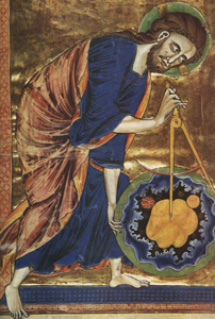
 “In creating the world, God used arithmetic, geometry,
and likewise astronomy.” – Nicholas of Cusa (click here for
article)
“In creating the world, God used arithmetic, geometry,
and likewise astronomy.” – Nicholas of Cusa (click here for
article)
It is widely supposed that thought precedes and anticipates action, that
conjectures precede experiments designed to test them and that science
provides a rational understanding of nature, which technologies merely
embody. Thus, in science as in other human activities, tools and technologies
are consequences of creative, intentional, purposive thought but have no
role in enabling or shaping thought. The pre-eminence of mind is also expressed
by the priority assigned to representations and reasoning processes in
cognitive psychology and, similarly, to ideas and arguments in the history
of science, with its corollary that technologies emerge from the application
of scientifically discerned principles. Until recently the design of intelligent
systems also presupposed that functional competence could be achieved by
providing a system with abstract representations of objects and processes
in an environment and with the means of reasoning with and about these.
This
view implies that systematic, rational thought is or can be separate from
the world that it seeks to understand, manipulate or control. It
is not easy to show how profoundly mistaken this view is. One source of difficulty
is that the priority of mental representations over physical manipulations
presupposes a mind-body dualism that has an established philosophical pedigree.
This dualism is associated with Descartes, whose optical ray-diagrams of
eyeballs gave us some of the earliest explanations of how images of the
material world are re-created in the theatre of the mind. There they can
be explored and manipulated in thought, by methods perfected and popularised
by Galileo, who embedded them in thought-experimental narratives. In the
work of Galileo, Newton and Einstein it appeared that thought could transcend
the limitations of embodied, sensory experience. Experiments and mere technological
extensions to our senses could only follow the lead of ratiocination. The
demonstrative force of thought experiments is taken by some to show that
Plato was right: the human mind can directly intuit the nature of reality.
If this view of knowledge and how we acquire it is correct then, as Dreyfus,
Edelman and others have argued, the anticipatory, instructional approach
to artificial intelligence should have been far more successful than it
has been.
This constraint is illustrated by an important feature of the history
of science. The sciences frequently run up against the limitations of a
way of representing aspects of the world – from material objects such as
fundamental particles to abstract entities such as numbers or space and
time. One of the most profound changes in our ability to describe aspects
of experience has involved developing new conceptions of what it is possible
to represent. Examples include the invention of Euclidean geometry as a
way of reasoning consistently about spatially extended objects; Cartesian
co-ordinates which linked geometrical and algebraic reasoning; the calculus,
which provided a way of reasoning about continuously changing variables;
the theory of probability as a way of calculating rather than estimating
the likelihood of events, and diagrammatic techniques in quantum physics
that represent properties of mathematical descriptions which themselves
already transcend the phenomenological or visual approach of classical
physics. Computer-based simulation methods may turn out to be a similar
representational turning point for the sciences. An important point about
these developments is that they are not merely ways of describing. Unlike
sense-extending devices such as microscopes, telescopes or cosmic ray detectors,
each enabled a new way of thinking about a particular domain.
Experiment as an Instrument of Innovation:,,Experience and Embodied Thought,,David C. Gooding, Science Studies Centre, Department of Psychology,,University of Bath, Bath BA2 7AY, UK (click for complete article)

